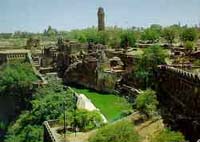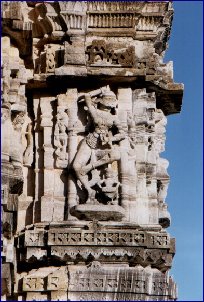| Destinations
|
|||||||||
The Fort is what Chittaur is famous for. It is located on a hilltop 6 kms away from the railway station. The history of the Fort is a history of the valiant traditions of Rajasthan. The city was ravaged three times and on all occasions the citizens resorted to the ultimate Rajput tradition of Jauhar, as honour was valued much more than death. The men rode out to war to face death and, knowing that defeat was imminent, the women and children created a huge funeral pyre and immolated themselves. The Pathan King of Delhi, Alauddin Khiji was the first to ransack the city in 1303 AD overpowered by a passionate desire for the beautiful queen Padmini. But he was never destined to possess her as she immolated herself along with the other women of the city.Two centuries later, in 1535, Bahadur Shah won a savage victory and the tradition of Jauhar was repeated. In 1568, the Emperor Akbar tried to take the city, again resulting in the same outcome. What to see: The Fort: A climb of a kilometre brings one up to this spectacular fort that was built by Maurya rulers in the 7th century AD. From its perch 180 metres high on a hill, it provides a magnificent view of the surroundings. |
More on Rajasthan • History • Geography • People & Culture • Economy • Festivals • Wild Life • Adventure • Climate Cities • Ajmer Shareif • Alwar • Bharatpur • Bikaner • Jaipur • Jaisalmer • Jodhpur • Kota • Mount Abu • Ranakpur • Sariska • Udaipur
Travelogues
Impressions | ||||||||
 The Fort has many gates, the main one being Ram Pol. The long walk around the Fort covers 7 kilometres and includes many sights, some of which are listed below. Two Chhatris, or memorials, are also visible while walking up. These were constructed to immortalise two valiant heroes of the battle against Akbar.
The Fort has many gates, the main one being Ram Pol. The long walk around the Fort covers 7 kilometres and includes many sights, some of which are listed below. Two Chhatris, or memorials, are also visible while walking up. These were constructed to immortalise two valiant heroes of the battle against Akbar.
Jaya Stambh (Tower of Victory) The tower was constructed by Maharaja Rana Kumbha to mark a victorious battle in 1440 AD over the Muslim rulers of Malwa and Gujarat. The nine-storey structure is 37 metres high and it is possible to climb some of the way up by the narrow stairs. It is decorated with sculptures dedicated to Hindu deities, some of which represent scenes from the Hindu epics of Ramayana and Mahabharata. Kirti Stambh (Tower of Fame) This tower is smaller but was built earlier in the 12th century AD by a Jain merchant who dedicated it to Adinath, the first of the Jain Tirthankaras. It is a Digambara (or sky clad) monument as it has naked figures of various Jain tirthankars.
Padmini's Palace
Archeological office and museum
TThese stand across the main palace and occupy a small portion of the comparatively recent Fateh Prakash Palace.
Also in the Fort compound are the Kumbha Shyam Temple, the Meera Temple and the Kalika Mata Temple.
Around Chittaur
Bassi Wildlife Sanctuary This is a small sanctuary 50 km away, that can be visited after obtaining permission from the District Forest Officer at Chittaur.
Bijaipur A 16th century castle stands at Bijaipur, 40 km from Chittaur. It has been converted into a heritage hotel.
How to get there:
Air: The nearest airport is Udaipur Airport, 90 km away.
Road: Buses take three hours from Udaipur.
Rail: Chittaurgarh is connected by rail to Udaipur (112 km) and Ajmer (182 km). It is also connected by rail to Jaipur, Ahmedabad and Delhi.
Where to stay
There are many hotels available near the railway station and the bus stand. Rajasthan Tourism runs a hotel in the centre of the town - Hotel Panna.
|
|||||||||
Editor: Romola Butalia (c) India Travelogue. All rights reserved. |
|||||||||

 The palace is built next to a large pool and has a pavilion in the centre, the same pavilion, 'Zanana Mahal', where the queen was standing when Alauddin Khilji caught a glimpse of her. The bronze gates to the palace are missing from here as they were carted away by Emperor Akbar, in the 16th century, and installed at the Agra Fort.
The palace is built next to a large pool and has a pavilion in the centre, the same pavilion, 'Zanana Mahal', where the queen was standing when Alauddin Khilji caught a glimpse of her. The bronze gates to the palace are missing from here as they were carted away by Emperor Akbar, in the 16th century, and installed at the Agra Fort.
 Menal: 90 km away, on the Bundi-Chittaur road, is a complex of ancient Shiva temples at Menal. It is a nice place to be during the monsoons as there are numerous waterfalls in an idyllic setting.
Menal: 90 km away, on the Bundi-Chittaur road, is a complex of ancient Shiva temples at Menal. It is a nice place to be during the monsoons as there are numerous waterfalls in an idyllic setting.